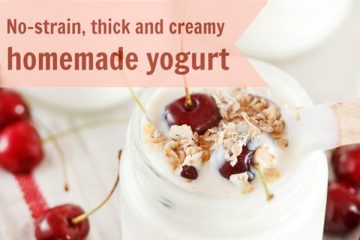
Is milk good? Is milk bad? The topic of milk consumption is loaded with lots of varying opinions weighing in with conviction and varying degrees of truth. Here are some common myths and facts and explanations in between:
ALL milk does a body good – MYTH.
The milk industry would have you believe that all milk (as long as it is pasteurized)- “Does a body good” and you too can achieve a “Body by Milk” akin to world class athletes and celebrities.
On the contrary, conventional milk – even most organic brands – is highly processed and comes from cows fed the wrong foods, and loaded with antibiotics and hormones to offset the poor conditions even in the finest conventional dairies.
The best milk comes from cows raised on pastures grazing on their natural diet of grass and clover. Corn and grain-fed cows are more prone to disease (such as e-coli contamination) since their digestive tracts are designed for grass not grain.
Pasteurization (invented to protect the population from milk-born diseases that festered in poorly run factory dairies and cows eating unhealthy grains) strips milk of naturally occurring vitamins, probiotics, enzymes, and vital nutrients, so even conventional organic dairy products are not an ideal health food.
Serve only low-fat (1%) and fat-free (skim) milk – MYTH.
The USDA suggests that everyone (including children over 2) drinks low-fat or fat-free milk claiming that they “provide calcium and other nutrients without a lot of saturated fat.” The truth is that reduced fat milks are stripped of fats and fat-soluble vitamins that are essential to health, and the milk proteins are denatured and actually is made toxic by the skimming process.
Cow milk is for baby cows – TRUE, but…
Vegans and other alternative thinkers encourage us to skip milk all together, claiming that, and that humans should choose “healthier” alternatives such as soy, rice, or nut milks or no dairy products at all. This advice detours us away from the potential health benefits of fresh, unpasteurized, non-homogenized dairy. The suggested substitutes are full of additives and preservatives and, even if homemade, are lacking in the nutrient density of high quality milk.
Just because cow's milk was designed for baby cows, doesn't necessarily preclude it from being a wonderfully nutritious food for healthy humans.
Milk produces phlegm – TRUE…and not.
This is an interesting one point that is supported by Chinese medicine. The fact is, dairy products, raw or otherwise will produce or exacerbate phlegm in a person with weak digestion. According to Chinese medicine, the Spleen meridian (the digestive system) does not like “cold” or “damp” (with ice cream being the quintessential example).
It stands to reason then, that a balance should be struck with dairy, and those with weak digestion, excess phlegm, “damp accumulation” or a compromised immune system should avoid dairy until they have recovered from their condition, whether acute or chronic.
Raw milk is a perfect health food – TRUE, for many.
“Real” or “raw” milk produced from clean, naturally healthy cows (or other milk producing animals) is a safe, nutrient dense alternative to commercial milk and dairy products. For optimal milk nutrition, the animals should graze on sunny pastures and eat a traditional diet of grass rather than corn, soy, or other farming bi-products.Old-fashioned breeds such as Jersey, Guernsey, Red Devon, or Brown Swiss cows, or goats, or sheep may provide superior quality milk compared to modern Holstein cows.
Raw milk from grass-fed cows is a traditional food has been consumed by humans since for over 10,000 years (Plank 49). It offers many health benefits as it is a complete food and a natural source of all the essential nutrients your body needs to function properly including protein, the eight essential amino acids, healthy fats including conjugated linoleic acid (CLA), minerals, vitamins A, D, and most B's, enzymes and cholesterol.
Raw dairy is even richer in nutrients and beneficial bacteria when consumed in the form of fermented or “soured” dairy products such as yogurt, kefir and raw cheeses. You can find out more about the health benefits of raw milk by visiting Raw-Milk-Facts.com.
What about milk allergies?
It it quite common to hear people say, “I am lactose intolerant.” or “I love dairy, but it doesn't love me.”
Here are three interesting points you may not know about dairy sensitivities:
#1 – Raw dairy contains lactase-producing bacteria.
These bacteria create lactase when they colonize the gut. (Lactase is the enzyme required to digest lactose – the milk sugar that can make milk cause gas, bloating, and cramping).
Pasteurization destroys these beneficial bacteria, rendering milk much more difficult to digest among a significant portion of the population. Therefore, may people who consider themselves lactose intolerant may find raw dairy benevolent to their tummies.
#2 – Digestibility of dairy products may depend on your ancestry.
All human babies naturally produce lactase to support digestion of mother's milk. This production wanes as a child approaches weaning age, though the body will continue to produce some lactase through adult life. People who have historically lived farther from the equator (and therefore could store fresh milk longer in the cooler clime) are genetically adapted to make more lactase and can digest unfermented dairy products with more ease than warm weather dwellers.
In warmer climates, where fresh milk sours faster, people traditionally produced and ate cultured dairy products such as yogurts, kefirs, and cheeses. The cultured dairy requires less lactase to digest since the lactose is partially broken down by the culturing process. Because of this, people that descend from warmer climates will often have more difficulty digesting fresh milk and cream as adults.
#3 – Dairy allergies and lactose intolerance can often be reversed.
The trick is to first remove all dairy from your diet, then gently reintroduce little by little starting with ghee (clarified butter) and then slowly and patiently in this order: butter, cultured dairy products such as yogurt and kefir, raw cheeses in small amounts, and finally raw cream and raw milk. Every person will have their own pace, and may require other support if their allergies/sensitivities are severe or complicated by other health issues.
Research on the benefits of raw milk for reducing food allergies is encouraging. According to an at RealMilk.com, an Austrian research study identified a significant reduction in asthma, hay fever, and allergy-related skin problems among children who consumed raw milk versus those who did not. According to the study, the biggest allergy reductions occurred among children who were consuming raw milk in the first year of life and continued to be exposed to it through age five.
Raw milk safety
Considering the health benefits of raw milk, you may wonder why anyone would opt for pasteurized milk, given its potential health risks. One reason is fear over illness from raw milk, but in fact, the right dairy farming practices make pasteurization completely unnecessary. If you know your raw milk source, you can ensure raw milk is safe for consumption. Raw milk produced from healthy, grass fed, “old-fashioned” cow breeds and clean, careful farming practices make “real” milk virtually risk free.
Up until recently, we just skipped milk in my household to circumvent the all the confusing information out there on the topic. But the more I've learn about milk and the importance of nutrient dense foods, milk and other raw, organic dairy products have become a staple in our home. I urge you to make this and all other decisions for yourself and your family based on what works best for you. Get informed and ask your body. You can find out more about choosing a safe source for raw milk at RealMilk.com.
Sources:
Plank, Nina. Real Food. Bloomsbury, New York: 2006.
Is milk bad…for you?
Let me know your experience in the comments!












I am with you — I was concerned about the safety of raw milk. In Oregon, there recently was an bacterial outbreak of raw milk, from a newer farm, and kids were hospitalized. Scary. That being said, I have started drinking raw goat’s milk again, and I feel great for it. Do you know the nutritional differences between raw goat’s and raw cow’s milk? Anne
We have been buying raw milk for several months now. We love the taste and knowing its benefits. HOWEVER, my son seems to get incredibly hyper after drinking it, either in the morning or night. Have you ever heard of this? It has gotten so bad that we may have to stop giving it to him, he gets hyper and naughty all at the same time, then if we stop for a few days, he is fine…. Thanks for the great info.
My daughter has a dairy/gluten sensitivity and had the same result. We’ve done a full elimination, gut healing (cutting out almost all sugars including any grains that are quick converters to sugar, probiotics and l-glutamine) and are now starting to reintroduce dairy. We’re just at the butter stage, but so far so good! You may have some gut healing work to do, too. Dairy on a weak digestive system (as well as gluten) can have substantial psychological effects (when there are holes in the lining of your stomack, the particles can actually get into your brain and cause impulsive/naughty behavior).The book Special Diets For Special People was great for explaining how it all works… Good luck!
I love that you share the Chinese Medicine perspective. As an ex-acupuncturist (yes, you read that right, and EX!!!) I appreciate it so much because it helps my understanding. I have thought of dairy as so ‘bad’ for so long but now do mindful (ish :)) dairy consumption and my kids enjoy raw milk. It’s great!
I love your blog!!
Thanks for everything!
xo
We love raw milk. We drive forty minutes round trip each week just to get our raw milk, GMO-free chicken eggs, and cheese made from the raw milk. I’m actually allergic to store purchased milk, but can have raw milk without any issues at all. Our milk is from Jersey cows and I can’t imagine not being able to get it. When I buy the milk, the children and I get to see the cows grazing in the field, eating the grass, and living a good life. The owners of the farm are lovely people and we feel great about where our money goes and what goes into our bodies. Thanks for the well written post!
Does anyone know how or why milk correlates with acne? There is no doubt that pasteurized milk products of any kind (including kefir and yogurt) cause cystic acne (for me). So far, raw milk is marginally better, but not perfect. Is this a matter of poor digestion or some kind of inherited milk intolerance? Any light that can be shed would be much appreciated!
I would think it would be poor digestion- you may need to do some gut work..generally most acne is a result of poor digestion. I do have good luck using coconut oil on my face, though. Even aside of addressing my gut it has been hugely helpful in eliminating breakouts. Not that I don’t think the gut is an important thing to address, because that clearly affects a lot of other areas as well…
I own herd shares for raw cow’s milk, and I would like to make raw milk yogurt. But I don’t understand why it’s recommended to boil the milk to kill its live bacteria before culturing with the starter. The instructions say that if I don’t boil the milk, the bacteria in the milk will compete with the bacteria in the yogurt starter and make it impossible to use the resulting yogurt as a starter for future batches of good tasting yogurt. Can anyone shed light on the process of making raw milk yogurt?
I have been having a lot of acne lately, I am wondering if it’s caused by milk. My digestion seems fine, I don’t have any gastrointestinal issues. I live in a state where raw milk is illegal. The milk we buy is local low-temperature pasturized.
Lactose isn’t usually the issue for those sensitive. It is milk protein, which occurs in conventional, organic, and raw dairy. This is most likely because it is something that was not designed for us to consume.
My cystic acne vanishes when I drink raw milk. When I travel for more than a couple of weeks and don’t have access to it, the cysts return, so the condition is obviously not ‘cured’. I come home, get back on the milk, and they completely disappear within a few days. Before trying raw milk (for reasons other than acne) I had tried different skincare as well as a long course of antibiotics. The same cystic pimples would remain, sometimes just one for over 9 months! Raw milk is so far the ONLY thing that the cystic pimples respond to. I haven’t touched pasteurised milk in 2 years.
This is great, but it’s impractical and makes me anxious when travelling. I wish I could find some information about what substance in the milk is having this effect, then I could at least have an emergency substitute. If anyone has any ideas please post! Can’t go to a doctor, he’d scoff at me (magical raw milk!?).
Since raw milk is so expensive, is there any benefit over organic milk from the grocery store when it comes to cooking with it? If I’m going to be hearing it or boiling it anyway, does that negate the benefits?
Hi, I’ve got a question. My Granny used to bring her fresh milk to a low boil and then bottled it. So basically that isn’t raw milk anymore, is it? Does the raw milk loose all enzymes and other good stuff in that process? She had always done that when she had a cow or bought fresh milk from a neighbor… after reading that part about raw milk I’m a little confused >,<
Hi Chris – Thanks for your comment. It would depend on how long it was boiled and at what temperature to determine the loss of nutrients. Since she got it from a neighbor, as apposed to a raw milk farmer with strict practices, it’s probably a good idea that she boiled it. Hope this helps!